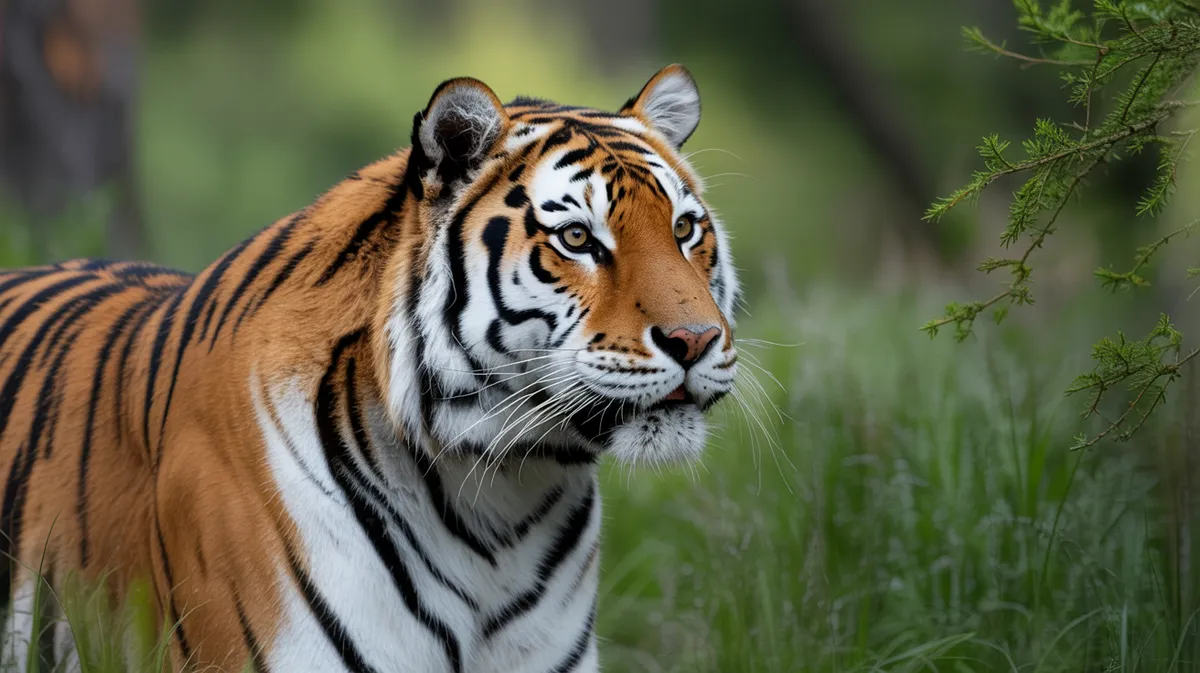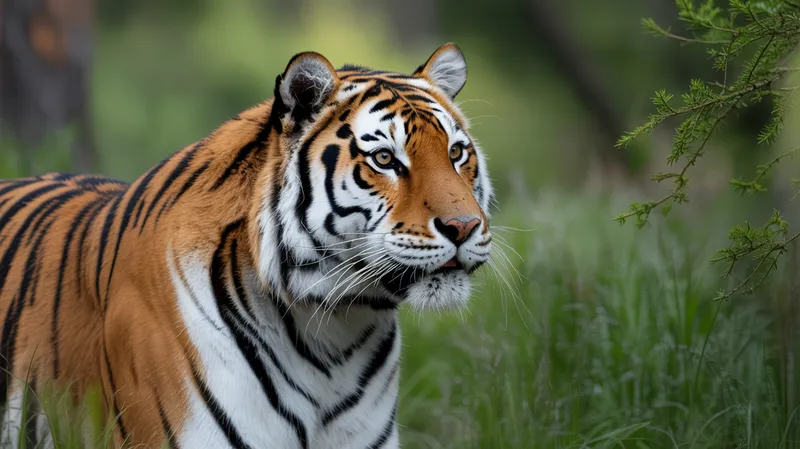
Siberian Tiger
Panthera tigris altaica

Meet the Siberian Tiger
The Siberian Tiger, also known as the Amur tiger, is the largest subspecies of tiger and the largest living cat in the world. It is distinguished by its thick, pale orange coat with fewer and paler stripes, which helps it blend into the snowy forests of eastern Russia. Adapted to cold climates, this solitary predator requires vast territories to roam and hunt large prey such as deer and wild boar. The population of Siberian tigers remains critically low due to habitat loss, poaching, and fragmentation.
Classification
Mammal
Habitat
Temperate forest
Diet
Carnivore
Lifespan
15-20 years in the wild
Conservation
Endangered
Weight
180-306 kg (400-675 lbs)
📖Fascinating Facts
Largest Wild Cat
The Siberian tiger holds the record as the largest living cat species, with some males weighing more than 300 kilograms.
Cold Climate Adaptation
This tiger has a dense, layered coat and a thick pad of fat to protect it from the freezing temperatures of its native habitats.
Vast Territory
A single Siberian tiger’s territory can cover up to 1,000 square kilometers, making them highly dependent on expansive, undisturbed forests.
📋Detailed Description
The Siberian tiger (Panthera tigris altaica) is the largest extant feline, with adult males typically weighing 180–306 kg (397–675 lbs) and measuring up to 3.3 meters (10.8 ft) in total length, including the tail. Females are smaller, averaging 100–167 kg (220–368 lbs). Its dense, pale orange coat with thick underfur and a layer of fat up to 5 cm (2 in) thick provides insulation against the harsh winters of the Russian Far East. The Siberian tiger’s skull is robust, with powerful jaw muscles and large canines (up to 7.5 cm/3 in) adapted for subduing large prey. Unlike other tiger subspecies, it has fewer and paler stripes, aiding camouflage in snowy and forested environments. This apex predator is primarily solitary, establishing vast territories—males may range over 500–2,000 km², while females typically occupy 200–400 km². Siberian tigers are crepuscular, most active during dawn and dusk, and are highly territorial, marking their range with scent markings and scratch marks on trees. Their diet consists mainly of large ungulates such as red deer, sika deer, wild boar, and occasionally elk and bear cubs. Siberian tigers play a keystone role in their ecosystem, regulating prey populations and maintaining ecological balance. Reproduction is seasonal, with cubs born in well-concealed dens, and maternal care is intensive for up to two years. Their population remains endangered, but recent conservation efforts have led to a slow recovery in some regions.
💡 Did you know?
Despite being apex predators, Siberian tigers may travel over 1,000 kilometers in search of food or mates due to the scarcity of prey in their habitat.
🔬Research & Sources
Wikipedia Summary
The Siberian tiger or Amur tiger is a population of the tiger subspecies Panthera tigris tigris native to Northeast China, the Russian Far East, and possibly North Korea. It once ranged throughout the Korean Peninsula, but currently inhabits mainly the Sikhote-Alin mountain region in south-west Primorye Province in the Russian Far East. In 2005, there were 331–393 adult and subadult Siberian tigers in this region, with a breeding adult population of about 250 individuals. The population had been stable for more than a decade because of intensive conservation efforts, but partial surveys conducted after 2005 indicate that the Russian tiger population was declining. An initial census held in 2015 indicated that the Siberian tiger population had increased to 480–540 individuals in the Russian Far East, including 100 cubs. This was followed up by a more detailed census which revealed there was a total population of 562 wild Siberian tigers in Russia. As of 2014, about 35 individuals were estimated to range in the international border area between Russia and China. As of 2022, about 756 Siberian tigers including 200 cubs were estimated to inhabit the Russian Far East.
Last Modified: 6/1/2025
🎭Behavior & Social Structure
Siberian tigers are solitary, with individuals only coming together for mating or when a mother is raising cubs. They are primarily nocturnal and crepuscular, using stealth and power to ambush prey, often stalking within 20–30 meters before launching a rapid attack. They are capable swimmers and will cross rivers and lakes in search of food or territory. Hunting success rates are relatively low (estimated at 10–15%), so tigers may travel up to 60 km (37 mi) in a night. They cache large kills, covering them with leaves or snow, and may return to feed for several days. Social interactions are limited, but overlapping territories may lead to confrontations, particularly between males. Scent marking, urine spraying, and vocalizations (roaring, chuffing, growling) are used for communication. Cubs are playful and learn hunting skills through imitation and practice with their mother.
👶Reproduction & Life Cycle
Mating can occur year-round but peaks from January to March. Females signal estrus through vocalizations and scent marking. After a gestation period of 93–112 days, females give birth to 2–4 cubs (occasionally up to 6) in a secluded den, often in dense vegetation or rocky crevices. Cubs are born blind and helpless, weighing about 800–1,600 grams (1.8–3.5 lbs). The mother nurses them exclusively for the first 6–8 weeks, after which she introduces solid food. Cubs begin accompanying their mother on hunts at 3–4 months and are fully weaned by 5–6 months. They remain with their mother for up to 2–3 years, learning essential survival skills before dispersing to establish their own territories. Sexual maturity is reached at 3–4 years for females and 4–5 years for males.
🛡️Adaptations & Survival
Siberian tigers possess several adaptations for survival in cold, forested environments. Their thick fur and subcutaneous fat layer provide insulation against temperatures that can drop below -40°C (-40°F). Large, padded paws act as snowshoes, distributing weight and aiding movement through deep snow. Their pale, widely spaced stripes offer camouflage among snow-laden trees. The robust skull and powerful jaw muscles enable them to tackle large prey and crush bones. Behavioral adaptations include wide-ranging movements to track prey across vast territories and the ability to swim across rivers, which helps them access isolated patches of habitat. Their acute senses of hearing and vision are crucial for nocturnal hunting.
📚Research Sources
🎨Cultural Significance
The Siberian tiger holds profound cultural significance in Russia, China, and Korea. It is revered as a symbol of strength, courage, and wilderness in Russian folklore and is featured in indigenous Nanai and Udege legends as a guardian of the forest. In China, the tiger is one of the 12 zodiac animals and represents power and protection. Historically, tiger parts have been used in traditional medicine, contributing to poaching pressures. The Siberian tiger is a flagship species for conservation in Northeast Asia and features prominently in regional art, literature, and conservation campaigns.
🔬Recent Research & Discoveries
Recent research has focused on the genetic diversity of Siberian tigers, revealing low but stable genetic variation due to historical population bottlenecks. Camera trap studies and GPS collaring have provided detailed insights into movement patterns, territory sizes, and habitat use. Conservation genetics is being used to monitor inbreeding and inform transboundary management between Russia and China. Ongoing studies are assessing the impacts of climate change on prey populations and habitat connectivity. Reintroduction and habitat restoration projects in Northeast China have shown promising signs of population recovery, with tigers recolonizing former range areas. Disease surveillance, particularly for canine distemper virus, is an emerging area of concern.
🎥Wildlife Videos

Exploring the Wild: The Majestic Siberian Tiger!
Discover the breathtaking world of the Siberian tiger in our exciting adventure, "Exploring the Wild: The Majestic Siberian Tiger!
Animal Profiles

Saving Siberian Tigers | A NATURE Short Film
Poaching, habitat loss and climate change are among the many threats to Siberian Tigers in Russia and the world. A group of ...
Nature on PBS

🐅Siberian Tiger: Ghost of the Taiga | A Wildlife Documentary
Step into the snow-covered wilderness of the Russian Far East and witness the breathtaking story of the Siberian tiger (Panthera ...
Road To Jrs

Cubs Meet Adult Tiger for the First Time | Tigers About The House | BBC Earth
As the cubs grow up Giles Clark thinks it's time for Spot and Stripe to start socialising with the adult tigers. Taken from Tigers About ...
BBC Earth

Protecting the Siberian Tiger's Last Home | Short Film Showcase
Rangers in eastern Russia are working tirelessly to protect the Ussuriskii State Nature Reserve, which is under threat from logging ...
National Geographic

Siberian Tiger | The Majestic Amur
Discover the hidden world of the Siberian tiger, also known as the Amur tiger, in this captivating 5-minute wildlife documentary!
WildByte Discoveries
🌍Habitat Information
The Siberian Tiger typically inhabits Temperate forest environments. Siberian Tigers have adapted to their environments with specialized features and behaviors.
Primary Habitat:
Temperate forest
More detailed habitat information will be available soon.
🛡️Conservation Status
The Siberian Tiger is currently classified as Endangered. Conservation efforts are crucial for preserving this species for future generations.
Common Threats:
- 🏠Habitat loss and fragmentation
- 🌡️Climate change impacts
- 🎯Hunting and poaching
- 🏭Human-wildlife conflict
⚠️Threats & Conservation Challenges
The primary threats to Siberian tigers are poaching for their body parts (used in traditional medicine), illegal hunting of prey species, habitat loss due to logging and infrastructure development, and human-wildlife conflict. Fragmentation of habitat isolates populations, reducing genetic diversity and increasing vulnerability to disease and inbreeding. Although anti-poaching patrols and stricter law enforcement have helped stabilize and increase populations in some areas, the species remains endangered. Climate change poses emerging threats, potentially altering prey availability and habitat structure. The current wild population is estimated at around 750 individuals (as of 2022), with most residing in the Russian Far East and a small, growing population in Northeast China.
🔬Scientific Classification
Scientific Name
Panthera tigris altaica
Classification Hierarchy
🔍 About Taxonomic Classification
Taxonomic classification is a hierarchical system used by scientists to classify and organize living organisms based on shared characteristics and evolutionary relationships.
The system moves from broad categories (Kingdom) to increasingly specific ones, with each animal's scientific name typically consisting of its Genus and species.
📝Community Notes
Share your observations and insights about the Siberian Tiger with our community of wildlife enthusiasts.
Join Our Community
Sign in to share your observations and connect with fellow wildlife enthusiasts.
Sign In to ContributeNo community notes yet
Be the first to share your observations about the Siberian Tiger!
Explore Siberian Tiger
Select a tab above to learn more about this amazing animal.
📸Photo Gallery
No photos available for this animal yet.
🌟Discover More Wildlife
Continue your journey of discovery with more fascinating animals from our database
